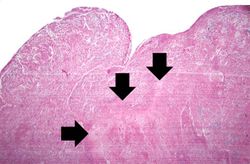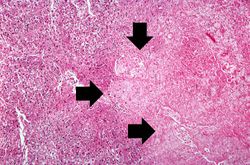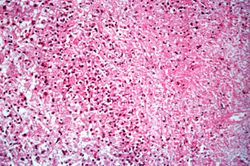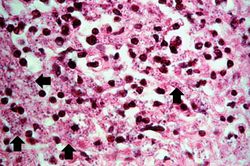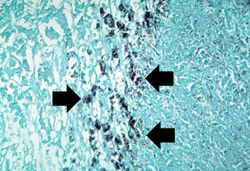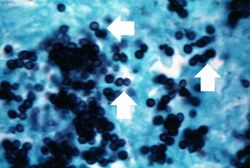Difference between revisions of "IPLab:Lab 10:Histoplasmosis"
| Line 27: | Line 27: | ||
4) a widely disseminated involvement, particularly in immunosuppressed patients.</spoiler> | 4) a widely disseminated involvement, particularly in immunosuppressed patients.</spoiler> | ||
| − | * <spoiler text=" "> | + | * <spoiler text="How do Histoplasma organisms infect cells?">Histoplasma conidia and yeasts bind to the beta-chain of the integrins receptors LFA-1 (CD11a/CD18) and MAC-1 (CD11b/CD18). |
| − | + | ||
| + | Histoplasma yeasts are phagocytosed by the unstimulated macrophages, multiply within the phagolysosome, and lyse the host cells.</spoiler> | ||
{{IPLab 10}} | {{IPLab 10}} | ||
[[Category: IPLab:Lab 10]] | [[Category: IPLab:Lab 10]] | ||
Revision as of 16:05, 21 August 2013
Clinical Summary[edit]
For four months before death, this two-year-old black female infant ate poorly and lost weight. When hospitalized, she appeared chronically ill with signs of infection. An exploratory laparotomy showed the patient had enormously enlarged abdominal lymph nodes, the biopsy of which disclosed active histoplasmosis. Despite intensive therapy, the patient died three weeks after admission.
Autopsy Findings[edit]
Autopsy showed widespread enlargement of lymph nodes, ulcers of the intestines, and enlarged adrenal glands exhibiting multifocal granulomas.
Images[edit]
This is an even higher-power photomicrograph of an area of necrosis (arrows). There is loss of cellular detail within this area. There are inflammatory cells present; however, it is difficult to differentiate the inflammatory cells from the native lymphocytes of the adrenal gland--which is a lymph node.
Study Questions[edit]
| |||||
An infiltrate is an accumulation of cells in the lung parenchyma--this is a sign of pneumonia.

